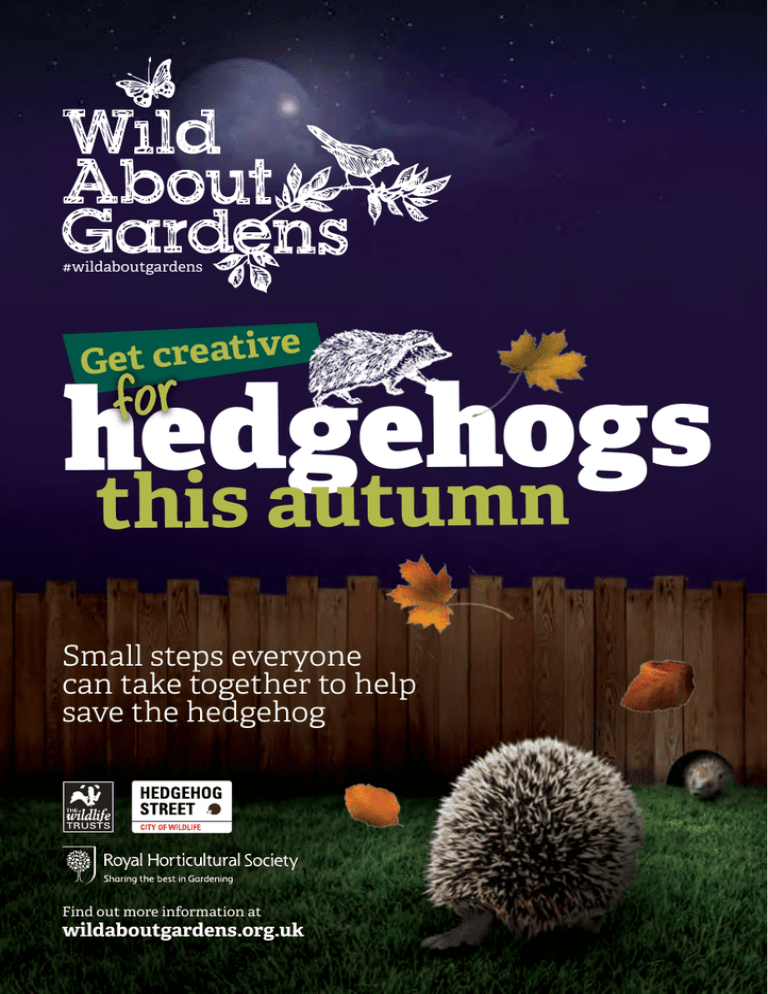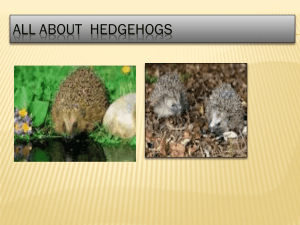Downloadable Booklet - Wild about gardens week
advertisement

#wildaboutgardens ve Get creati ogs hedgeh umn fo r this aut Small steps everyone can take together to help save the hedgehog Find out more information at wildaboutgardens.org.uk How well do you know these spiny garden visitors? On the menu Hedgehogs are most famous for eating slugs and snails, but they eat a huge range of other garden invertebrates too. In fact, beetles, earthworms and caterpillars make up most of their diet, whereas large snail shells can prove tricky for hedgehogs to tackle. If you want hedgehogs, you need creepy crawlies in abundance which can be attracted by planting a variety of different plants and creating habitats such as log piles. Hedgehogs must feed intensively and be in great condition before hibernating 02 wildaboutgardens.org.uk There are 14 different species of hedgehog around the world. The UK’s hedgehog – the European hedgehog – is found across Western Europe and Scandinavia. Gillian Day Home range & distribution Hedgehogs are found across the UK, absent only from some Scottish islands. Gardens, hedgerows, woodlands, grasslands, parks and cemeteries are all important hedgehog habitats. Adult hedgehogs travel between 1-2km per night over home ranges as big as 10-20 hectares in size. In suburban areas, this means they range over entire housing estates and neighbourhoods. Did you know...? Particularly slippery slugs are sometimes de-slimed with deft forepaws before eating. 2-5years On average hedgehogs live for in the wild, but some have lived up to 10! 7,000 An adult hedgehog has up to Breeding During the breeding season amorous hedgehogs can be seen (and heard!!) circling each other with snorts and grunts. Young are usually born from May onwards in litters of up to five and the young leave the nest after around four weeks. Baby hedgehogs (or hoglets) are born with their spines sheathed beneath their skin which then emerge a few hours after birth. Hibernation While many animals have adapted to cope with the harsh conditions of winter, hedgehogs are one of only a handful of UK mammals to truly hibernate, along with bats and dormice. Depending on the weather and their body condition, they enter a state of torpor from October/ November to March/April, lowering their body temperature and slowing their metabolism to save energy. Hedgehogs must feed intensively and be in great condition before hibernating if they are to have enough reserves to last the winter. spines and a small, hidden tail. Hedgehogs are in trouble... Some hedgehogs are blonde! This colour mutation is called leucism and is thought to be caused by rare recessive genes. Over the past 50 years we’ve seen declines in two thirds of the UK’s plant and animal species, including many of our once common garden species. Hedgehog numbers have fallen by in just over 30 percent 10 years 1 million and there are now thought to be fewer than left in the UK. They are disappearing from our countryside as fast as tigers are worldwide. wildaboutgardens.org.uk 03 How To Help: Living in an urban area needn’t mean that you can’t help the ‘hog. Here are some top tips for getting involved: Welcoming the hedgehog Create hedgehog highways Hedgehogs need to be able to roam far and wide in search of food, mates and nesting sites. Get together with your neighbours to cut a 13cm x 13cm hole (5in) hole in your fence or dig a channel beneath garden boundaries to connect your gardens. You can then add your hedgehog hole to our national network at HedgehogStreet.org. Avoid the use of pesticides Ditch the slug pellets and avoid the use of pesticides. Hedgehogs are natural “pest” controllers and need a plentiful and varied supply of invertebrate prey to stay healthy. Make water safe Hedgehogs are great swimmers but can sometimes struggle to climb out of steepsided ponds and many drown. Provide a ramp from a plank wrapped in chicken wire or create shallow areas at the edge so they can scramble out. Provide nesting sites Log and leaf piles, wilderness areas and purpose-built hedgehog homes make great places for hedgehogs to nest and hibernate. Fallen leaves also make the perfect nesting material, so make sure you don’t clear all of these away. 04 wildaboutgardens.org.uk Grow a wide variety of plants Attract plenty of natural hedgehog food by keeping your garden diverse with a wide variety of habitats e.g. ponds, log piles, hedges, and a wide range of plant types. Don’t be afraid to let your grass grow a little wild and leave some leaf litter – as both are important homes for the hedgehog’s prey. Be aware of dangers Check for hidden hedgehogs before lighting bonfires, strimming and mowing the lawn. Keep plant netting, tennis nets and household rubbish above ground level to prevent entanglement. Log and leaf piles, wilderness areas and purpose-built hedgehog homes make great places for hedgehogs to nest If you live in a flat, try and influence the management of local greenspace by attending management meetings or joining the ‘friends of’ group. David Coope r To save the hedgehog we need people to work together with neighbours to make small changes that will make a big difference. This is crucial because no garden or green space can help hedgehogs in isolation, but when they are linked together hedgehogs can thrive in any location. Post some invitations around your local neighbours to make them aware of what they can do to help. You could even throw a hedgehog-themed party to break the ice. Check out the website: hedgehogstreet.org You can map any hedgehogs you may see, tell us about the hole in your fence or become a Hedgehog Champion and get stuck in right away. If you do have ‘hogs in your garden, you could set up a feeding station by cutting a hole in a plastic storage box and weighing down the lid with bricks: this will stop cats and foxes taking the food. If you are worried about rats, don’t put out grainbased foods on the floor. Take in any excess food when your hedgehogs have been for a visit. Keep an eye out for people doing work on their gardens, or using fencing contractors - this is a prime time to get a hedgehog hole put in and influence connectivity. What do I do if I find an underweight hedgehog? If you’re concerned about underweight hedgehogs or hedgehogs active in winter, provide tinned cat or dog food and fresh water. The British Hedgehog Preservation Society can offer advice and help you find a rescue centre near you: w.britishhedgehogs.org.uk e. info@britishhedgehogs.org.uk t. 01584 890 801 wildaboutgardens.org.uk 05 Working together Key 1. Create ‘hedgehog highways’ in your fences to connect your gardens. 2. Provide an escape route out of ponds – ‘hogs are great swimmers but they struggle to climb out. 3. Create a variety of habitats e.g. ponds, hedges, log piles and compost heaps to attract food for the hedgehog. 4. Build a hedgehog home – give them somewhere to hunker down for the winter. 5. Let your grass grow wild (or even a section of it) to encourage the hedgehog’s prey. Check carefully before mowing or strimming areas. 6. Create nesting opportunities – leave wild areas for ‘hogs to hibernate. 7. Set up a feeding station offering hedgehog food or meaty pet food and water. 8. Tidy up – litter harms wildlife, and hedgehogs can also become entangled in garden netting. 9. Keep domestic drains covered, hedgehogs can fall into them and get stuck. 10. Check bonfires before lighting; ideally rebuild them on the day it is to be lit. 11. Keep your gardens green – paving and decking over gardens reduces hedgehog habitat. Take these small steps to welcome hedgehogs into your neighbourhood. 6 10 8 11 4 2 1 06 wildaboutgardens.org.uk 7 9 5 3 wildaboutgardens.org.uk 07 wildaboutgardens.org.uk wildaboutgardens.org.uk Make a deluxe hedgehog house wildaboutgardens.org.uk Make a simple hedgehog house Produced in collaboration with Hedgehog Street #wildaboutgardens Produced in collaboration with Hedgehog Street #wildaboutgardens © corinne welch, copyright Royal Society of Wildlife Trusts 2015 © corinne welch, 2015 08 wildaboutgardens.org.uk 09 Hedgehog Delicacies Hedgehogs eat a variety of insects, molluscs and other invertebrates, often switching from one food type to the other depending on the time of year. How does your garden stack up as a hedgehog buffet? 1.3% flies & leatherjackets 1.1 % bird feathers 3.0% earwigs Tick off the menu items you’ve seen 3.0% all wasps, bees & ants 3.4% millipedes 0.6% others 0.4%* * spiders & ticks, harvestmen, woodlice, centipedes. 4.7% Earthworm Leatherjacket (cranefly larva) Earwig Millipede 5.3% 10.7% ** slugs & snails Snail Slug Ground beetle beetles mammals bird eggs earth worms Caterpillar 27.2% 13.0% caterpillars 26.0% Data from Yalden, D.W. (1976) The food of the hedgehog in England. Acta Theriologica 21: 401-424 **study examined animals that were trapped by gamekeepers using eggs as bait, so the proportion of eggs in a natural diet is likely to be lower. Beetle larva 10 wildaboutgardens.org.uk Chafer beetle Weevil Butterfly/ moth pupa Image credits for p 10. Leatherjacket - RHS / P. Becker. Millipede - Joy Russell. Caterpillar - Chris Maguire. Ground beetle - Margaret Holland. Beetle larva - RHS / Andrew Halstead. Chafer beetle - David Longshaw. Weevil - Margaret Holland. Butterfly - Joyce Maynard. wildaboutgardens.org.uk 11 Gardening For Hedgehogs 4 dall Tim San Wood pile Encourages a rich feast of earwigs, centipedes and woodlice! Encourage a glut of the hedgehog’s favourite food by creating micro-habitats that are great for invertebrates! Oliver Kite Choose plant species that are attractive to a range of insects 1 P.Becke r Have a look at the RHS Perfect for Pollinators list for suggestions: rhs.org.uk/perfectforpollinators 5 Tim Sandal Will harbour insects including leatherjackets. Richard l 2 Mulch beds with garden compost Encourages plenty of earthworms, woodlice and beetles as it begins to rot down! Tom Marshall Allow a patch of grass to grow long 3 Dawson Fallen leaf pile ‘Build a bug hotel’ Stuff it with lots of straw and hollow plant stems and earwigs, centipedes and woodlice will soon make it their home. Provides the perfect shelter for ground beetles. 7 8 Create nesting opportunities all Tom Mar sh Richard Dawson 12 6 wildaboutgardens.org.uk Leave prunings and leaves in a wild corner for hedgehogs to make nests with. Hogs love apple and cherry leaves, and hawthorn and honeysuckle prunings make good structural supports. Leave hollow plant stems over winter The perfect hiding place for ladybirds! wildaboutgardens.org.uk 13 wildaboutgardens.org.uk wildaboutgardens.org.uk Leave your garden wild .wildaboutgardens.org.uk #wildaboutgardens #wildaboutgardens Produced in collaboration with Hedgehog Street How to make an animal footprint trap © corinne welch, copyright Royal Society of Wildlife Trusts 2015 © corinne welch, 2015 14 wildaboutgardens.org.uk 15 About Us For more information about how you can help wildlife in your garden, including gardening advice, activity ideas and species guides, visit The Wildlife Trusts and RHS partnership website wildaboutgardens.org.uk The Wildlife Trusts The Wildlife Trusts are the UK’s largest peoplepowered organisation caring for all nature – rivers, bogs, meadows forests, seas and much more. There are Wildlife Trusts covering the whole of the UK with a shared mission to restore nature everywhere we can and to inspire people to value and take action for nature. Many Wildlife Trusts run projects to specifically address the disappearance of our hedgehogs, including raising awareness amongst local communities, recording sightings, encouraging people to take action at home to help and targeting hedgehog hotspots for conservation effort.Find out more about some of these projects and how you can get involved at wildlifetrusts.org/hedgehogs The Wildlife Trusts, The Kiln, Mather Road, Newark, Nottinghamshire, NG24 1WT t: 01636 677711 e: info@wildlifetrusts.org w:wildlifetrusts.org @wildlifetrusts The Royal Horticultural Society For more than 210 years the Royal Horticultural Society has been the force behind gardening in the UK. We’re driven by a desire to enrich everyone’s life through plants, and make the nation a greener, more beautiful place. We believe that everyone in every village, town and city should benefit from growing plants to enhance lives, build stronger, healthier, happier communities, and create better places to live. Our work in education, science and communities is only possible thanks to the generous support of our visitors, members, partners, donors and sponsors. With your help we can harness the power of horticulture, one gardener at a time. The Royal Horticultural Society, 80 Vincent Square, London, SW1P 2PE t: 0845 260 5000 e: membership@rhs.org.uk w:rhs.org.uk /wildlifetrusts Registered Charity No 207238 Registered Charity No 222879/SC038262 Hedgehog Street Hedgehog Street is a campaign by People’s Trust for Endangered Species (PTES) and the British Hedgehog Preservation Society (BHPS) aimed at ensuring the hedgehog, the UK’s only spiny mammal, remains a common and familiar part of British life. We know hedgehogs are in trouble. We’ve lost a third of all our hedgehogs in ten years. Fortunately, hedgehogs love gardens, and there are around half a million hectares of garden in the UK. Hedgehogs need access to lots and lots of different gardens to survive, so this campaign is as much about getting people to cooperate as it is about gardening for wildlife. Hedgehog Street has over 34,000 volunteer “Hedgehog Champions” right across the UK. Wherever you live, the green space in your local area can be a vital refuge for hedgehogs. Hedgehog Street, 3 Cloisters House, 8 Battersea Park Road, London, SW8 4BG t: 020 7498 4533 e: hedgehog@ptes.org w:hedgehogstreet.org Registered Charity No.s PTES 274206 / BHPS 326885 Find out more information at wildaboutgardens.org.uk





